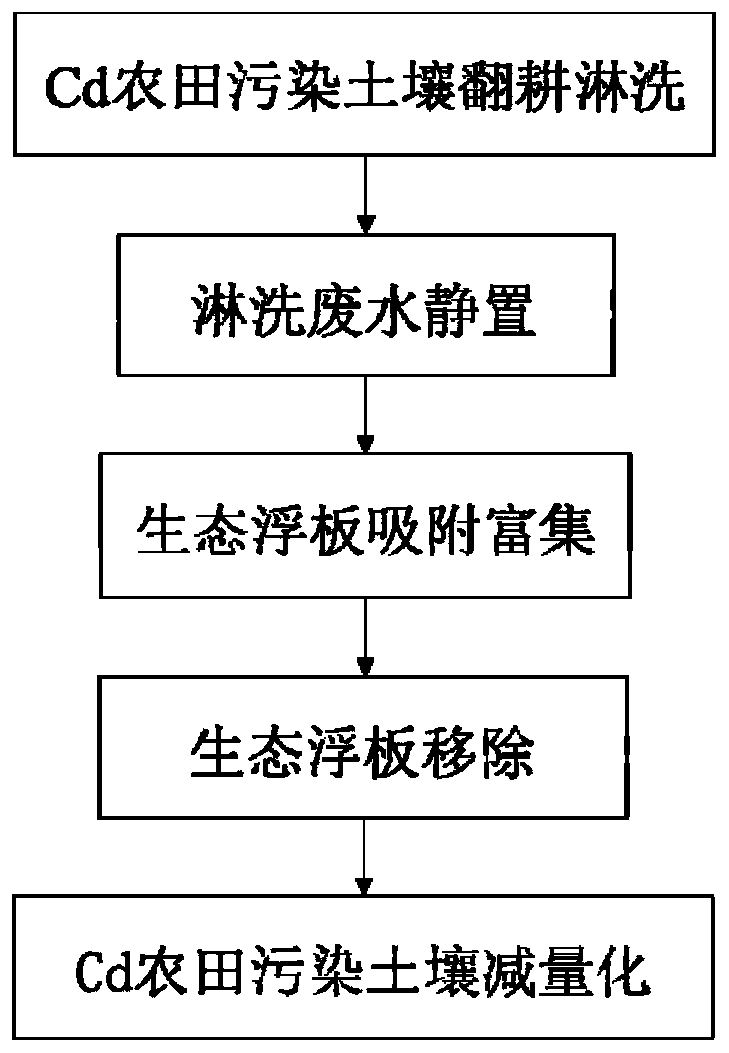In-situ decrement remediation method for cadmium-polluted farmland
A remediation method and technology for cadmium pollution, applied in the field of soil pollution remediation of environmental protection, can solve problems such as high cost, low Cd reduction efficiency, complicated operation, etc., achieve long plant growth cycle, increase treatment steps and costs, and remediation efficiency. low effect
- Summary
- Abstract
- Description
- Claims
- Application Information
AI Technical Summary
Problems solved by technology
Method used
Image
Examples
Embodiment 1
[0051] Take 1000 g of farmland Cd-contaminated soil, in which the Cd content is 1.64 mg / kg, and the available Cd content is 0.63 mg / kg. 8 mMFeCl respectively 3 , 8 mM citric acid, compound eluent (FeCl 3 (5 mM) + citric acid (3 mM)) as the eluent, deionized water as the blank sample, rinse the contaminated soil, put the contaminated soil in a beaker, the eluent coverage height is 5 cm, rinse for 12 hours, See Table 1 for the leaching rate of Cd (1.64mg / kg) in the soil.
[0052] Table 1 The leaching effect of different leaching agents on available Cd and total Cd in soil
[0053]
[0054] It can be seen from Table 1 that the leaching agent mainly acts on the available Cd in the soil, and the compound leaching agent FeCl 3 + A rinse with citric acid works best. Use FeCl 3 (5 mM) + citric acid (3 mM) leached soil to achieve a leaching rate of total Cd of 13.1%, which was much higher than the expected value, while the leaching rate of the compound leaching agent to effecti...
Embodiment 2
[0056] Configure eluent solution (FeCl 3 (5 mM) + citric acid (3 mM)), while plowing and crushing the farmland soil to be repaired, introduce the eluent solution through the water inlet 6 to the field and continue plowing, so that the heavy metal Cd in the soil can be leached and dissolved and transferred to the eluent; stand still for 24 hours, so that the field leaching wastewater is allowed to stand and stratify, and the water coverage depth in the farmland is 10cm; the ecological floating board is put into the leaching wastewater (the input density is 3 / m 2 ), use the floating plate to make it float on the rinsing wastewater, place it for 30 days and take it out, and the rinsing wastewater can be discharged through the outlet pipe 7. The leaching rate of Cd in soil, the removal rate of Cd in leaching water, and the enrichment rate of Cd in Cd-enriched plants were measured.
[0057] Measured by the atomic absorption spectrometer, the content of Cd in the leaching water is ...
Embodiment 3
[0061] Repeat Example 2, the only difference is that in this example, the volume ratio of sesame straw biochar to attapulgite in the planting tank is controlled to be 1:5.
[0062] Such as Figure 8 It was shown that with the increase of the proportion of clay in the planting tank matrix, a large amount of clay was adsorbed on the surface of biochar, which hindered the adsorption effect of biochar in the mixed matrix, so the adsorption efficiency of planting tank matrix for Cd became worse.
PUM
 Login to View More
Login to View More Abstract
Description
Claims
Application Information
 Login to View More
Login to View More - R&D
- Intellectual Property
- Life Sciences
- Materials
- Tech Scout
- Unparalleled Data Quality
- Higher Quality Content
- 60% Fewer Hallucinations
Browse by: Latest US Patents, China's latest patents, Technical Efficacy Thesaurus, Application Domain, Technology Topic, Popular Technical Reports.
© 2025 PatSnap. All rights reserved.Legal|Privacy policy|Modern Slavery Act Transparency Statement|Sitemap|About US| Contact US: help@patsnap.com



